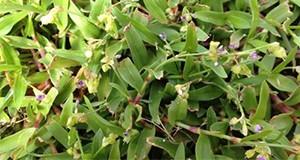
Spiderwort is a native perennial species found throughout the eastern half of the US. The plant’s large, fleshy stem creates problems for hay production. This 2-page fact sheet provides a brief overview of the plant as well as information on control through herbicide use. Written by Michael Durham, Jason Ferrell, and Brent Sellers, and published by the UF Agronomy Department, May 2016.
http://edis.ifas.ufl.edu/ag407
Tag: Commelinaceae (taxonomic family)
Doveweed (Murdannia nudiflora) Control in Warm-Season Turfgrass Species
 Doveweed is an aggressive, naturalized summer annual weed that rapidly invades warm-season turfgrass species, especially in residential lawns, and few herbicides can effectively control it. Because of these challenges, a well-designed management strategy is necessary for doveweed control. This 4-page fact sheet describes identification, growth requirements, chemical control and cultural practices. Written by Ramon G. Leon and Bryan Unruh, and published by the UF Department of Agronomy, June 2015.
Doveweed is an aggressive, naturalized summer annual weed that rapidly invades warm-season turfgrass species, especially in residential lawns, and few herbicides can effectively control it. Because of these challenges, a well-designed management strategy is necessary for doveweed control. This 4-page fact sheet describes identification, growth requirements, chemical control and cultural practices. Written by Ramon G. Leon and Bryan Unruh, and published by the UF Department of Agronomy, June 2015.
http://edis.ifas.ufl.edu/ag395
Prevention, Early Detection, and Eradication of Benghal Dayflower in Field Nurseries (ENH1085/EP350)
Benghal dayflower is an increasingly problematic weed that is federally designated as a noxious weed. This 10-page fact sheet provides nursery owners how to prevent, detect, and eradicate this invasive plant. Written by Robert Stamps, and published by the UF Department of Environmental Horticulture, May 2011.
http://edis.ifas.ufl.edu/ep350
ENH1085/EP350 Some Suggestions for Controlling Benghal Dayflower in Field Nurseries
ENH-1085, a 9-page illustrated fact-sheet by Robert Stamps, describes this increasingly problematic weed — also known as jio, tropical spiderwort, hairy wandering jew, and Indian dayflower — in field nurseries, its identification, control, factors effecting pre- and post-emergence herbicides, tables of recommended herbicides, and references. Published by UF Department of Environmental Horticulture, January 2008.
http://edis.ifas.ufl.edu/EP350